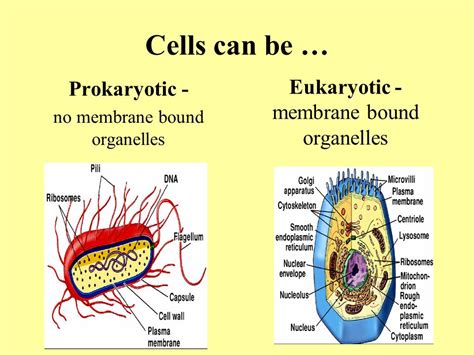Introduction

Prokaryotic cells, the simplest and smallest type of cell, are characterized by their lack of a nucleus and other membrane-bound organelles. While eukaryotic cells contain a variety of organelles that compartmentalize cellular functions, prokaryotic cells have a simpler organization with fewer membrane-bound compartments.
Membrane-Bound Organelles in Eukaryotic Cells
Membrane-bound organelles are structures within eukaryotic cells that are enclosed by lipid bilayers. These include:
- Nucleus: Contains the cell’s genetic material (DNA).
- Mitochondria: Generate energy through cellular respiration.
- Endoplasmic Reticulum (ER): Produces proteins and lipids, and transports them throughout the cell.
- Golgi Apparatus: Modifies and packages proteins and lipids.
- Lysosomes: Contain digestive enzymes that break down cellular waste and foreign particles.
Membrane-Bound Structures in Prokaryotic Cells
Although prokaryotic cells do not have membrane-bound organelles in the same way as eukaryotic cells, they do possess some membrane-bound structures:
- Plasma Membrane: The outer boundary of the cell, which regulates the exchange of materials.
- Mesosomes: Infoldings of the plasma membrane that are involved in cell division and respiration.
- Thylakoids: Membrane-bound sacs in photosynthetic bacteria that contain chlorophyll and carry out photosynthesis.
- Carboxysomes: Structures that enclose enzymes involved in carbon dioxide fixation in some bacteria.
Comparison of Membrane-Bound Organelles in Prokaryotic and Eukaryotic Cells
| Feature | Prokaryotic Cells | Eukaryotic Cells |
|---|---|---|
| Nucleus | Absent | Present |
| Mitochondria | Absent | Present |
| Endoplasmic Reticulum | Absent | Present |
| Golgi Apparatus | Absent | Present |
| Lysosomes | Absent | Present |
| Plasma Membrane | Present | Present |
| Mesosomes | Present | Absent |
| Thylakoids | Present (photosynthetic bacteria only) | Present (plant cells only) |
| Carboxysomes | Present (some bacteria only) | Absent |
Functional Implications of the Absence of Membrane-Bound Organelles in Prokaryotic Cells
The lack of membrane-bound organelles in prokaryotic cells has several functional implications:
- Smaller Size: Prokaryotic cells are typically much smaller than eukaryotic cells, as the absence of organelles allows for a more compact organization.
- Reduced Complexity: Prokaryotic cells have a simpler metabolic machinery compared to eukaryotic cells and do not perform the same level of cellular compartmentalization.
- Faster Growth Rate: The lack of membrane-bound organelles allows prokaryotic cells to grow and divide more rapidly than eukaryotic cells.
Applications of Prokaryotic and Eukaryotic Cell Organization
The distinct cellular organization of prokaryotic and eukaryotic cells has led to their specialized applications:
-
Prokaryotic Cells:
- Biotechnology: Used in genetic engineering, biofuel production, and wastewater treatment.
- Medicine: Used in antibiotics, vaccines, and probiotics.
-
Eukaryotic Cells:
- Medicine: Used in cancer treatments, gene therapy, and drug discovery.
- Agriculture: Used in genetic engineering to improve crop yields and resistance to pests.
Conclusion
Membrane-bound organelles are a defining feature of eukaryotic cells, allowing for compartmentalization and cellular complexity. While prokaryotic cells lack membrane-bound organelles in the same way, they possess membrane-bound structures that perform specialized functions. The distinct cellular organization of prokaryotic and eukaryotic cells has significant implications for their function, size, growth rate, and applications.
